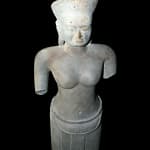Khmer Sculpture of Uma, 1200 CE - 1300 CE
Sandstone
26.5
PF.5538
Further images
The goddess Uma, also known as Parvati, daughter of the mountains, was the consort of Shiva. When she finally attracted Shiva, after a long and physically grueling courtship, he shared...
The goddess Uma, also known as Parvati, daughter of the mountains, was the consort of Shiva. When she finally attracted Shiva, after a long and physically grueling courtship, he shared with her the secrets of the world, a conversation that would lead to the dispersal of this elite knowledge amongst the wise. Shiva’s exploits were represented on the relief carvings of Angkor Wat, the center of the Khmer dynasty and the largest religious monument in the world. Thus, Uma was a favored goddess of Khmer artists for her important stature in the Hindu hierarchy.
The artistic glory of the Khmer civilization is perfectly preserved in this sculpture of Uma. Stylistically, the idealized forms of the figure are characteristic of Angkor. The smooth polish of the surface, the hourglass-shape of the torso, and the facial structure of this statue are typically Khmer. The floral diadem tied into a knot at the back of her head and the pleated sarong with overhanging fabric carved in the shape of a fishtale are also both indicative of Khmer sculpture of this period. The idealization of the figure is the direct result of her divine nature. Gazing upon this masterpiece, we are in the presence of not only a gorgeous goddess, but also a relic of one of history’s great civilizations. Like all great art, this sculpture memorializes an entire culture and era. The art and architecture of the Khmer is one of the greatest achievements of mankind. Basking in the glory of this sculpture is reveling in the beauty of life and creation itself. It’s no wonder that early legends surrounding Angkor, before it was properly excavated and documented, purported it to be a city created by the gods when they still resided on earth. Somehow, this sculpture of Uma seems like a divine self-portrait.
The artistic glory of the Khmer civilization is perfectly preserved in this sculpture of Uma. Stylistically, the idealized forms of the figure are characteristic of Angkor. The smooth polish of the surface, the hourglass-shape of the torso, and the facial structure of this statue are typically Khmer. The floral diadem tied into a knot at the back of her head and the pleated sarong with overhanging fabric carved in the shape of a fishtale are also both indicative of Khmer sculpture of this period. The idealization of the figure is the direct result of her divine nature. Gazing upon this masterpiece, we are in the presence of not only a gorgeous goddess, but also a relic of one of history’s great civilizations. Like all great art, this sculpture memorializes an entire culture and era. The art and architecture of the Khmer is one of the greatest achievements of mankind. Basking in the glory of this sculpture is reveling in the beauty of life and creation itself. It’s no wonder that early legends surrounding Angkor, before it was properly excavated and documented, purported it to be a city created by the gods when they still resided on earth. Somehow, this sculpture of Uma seems like a divine self-portrait.
Literature
V30











